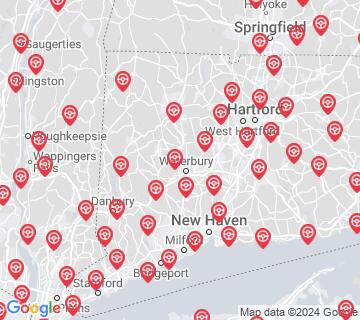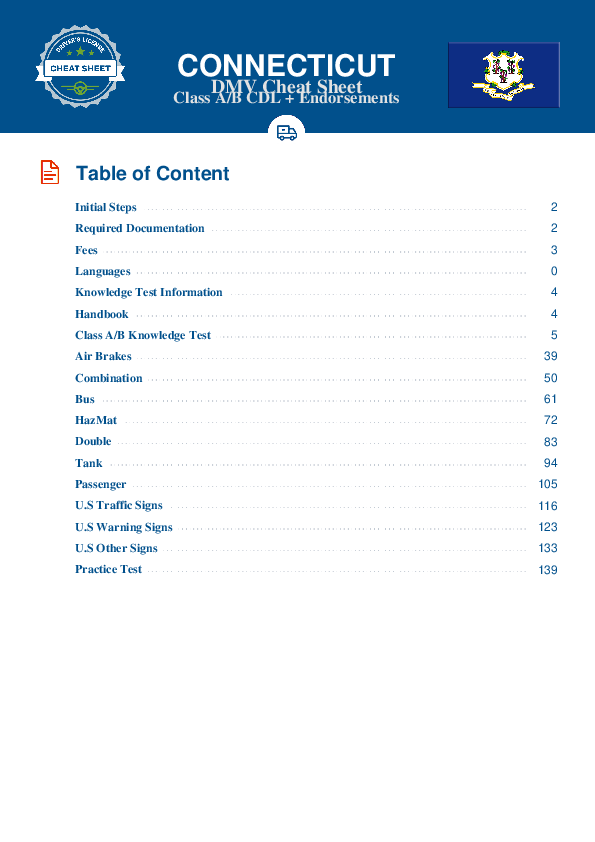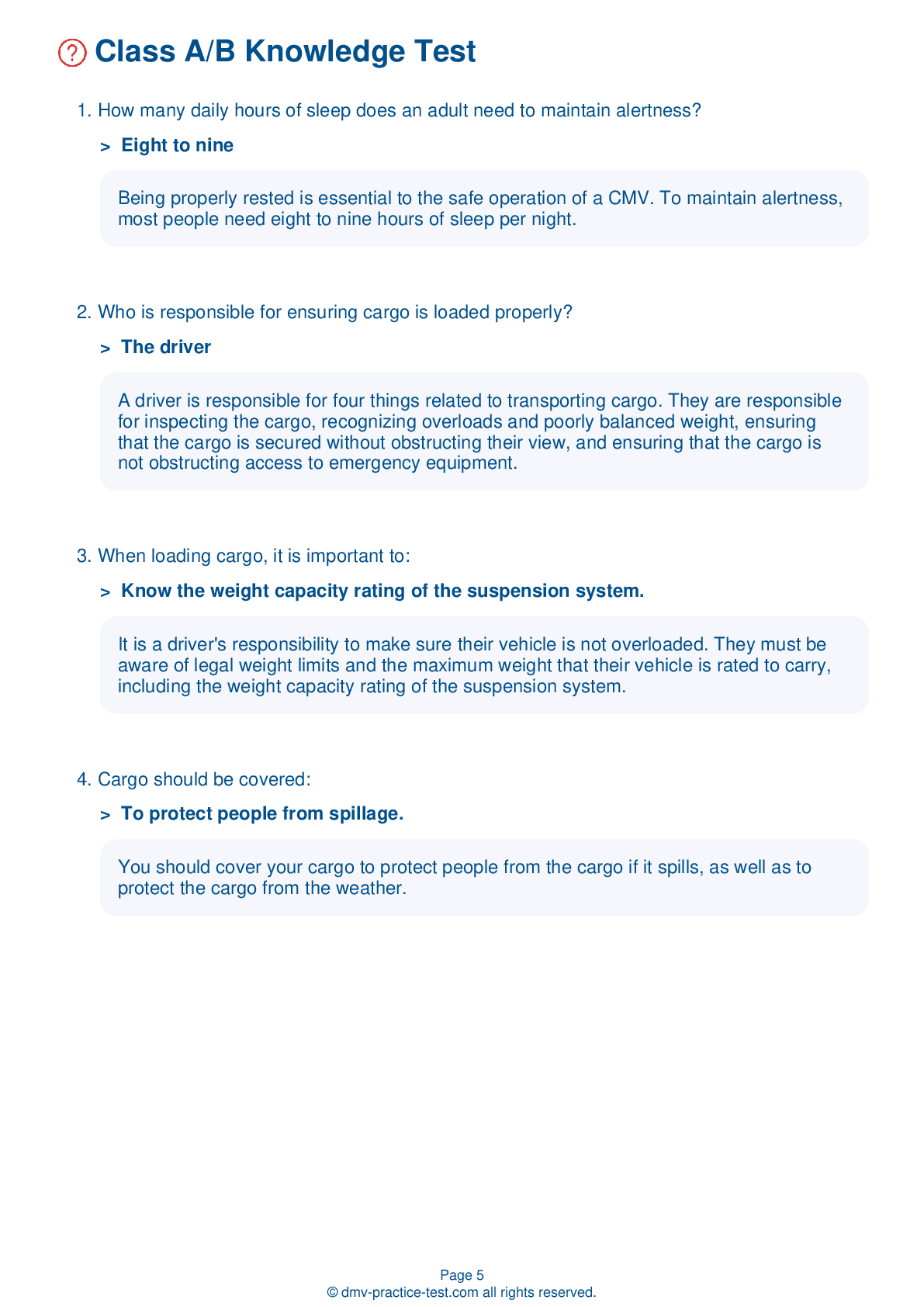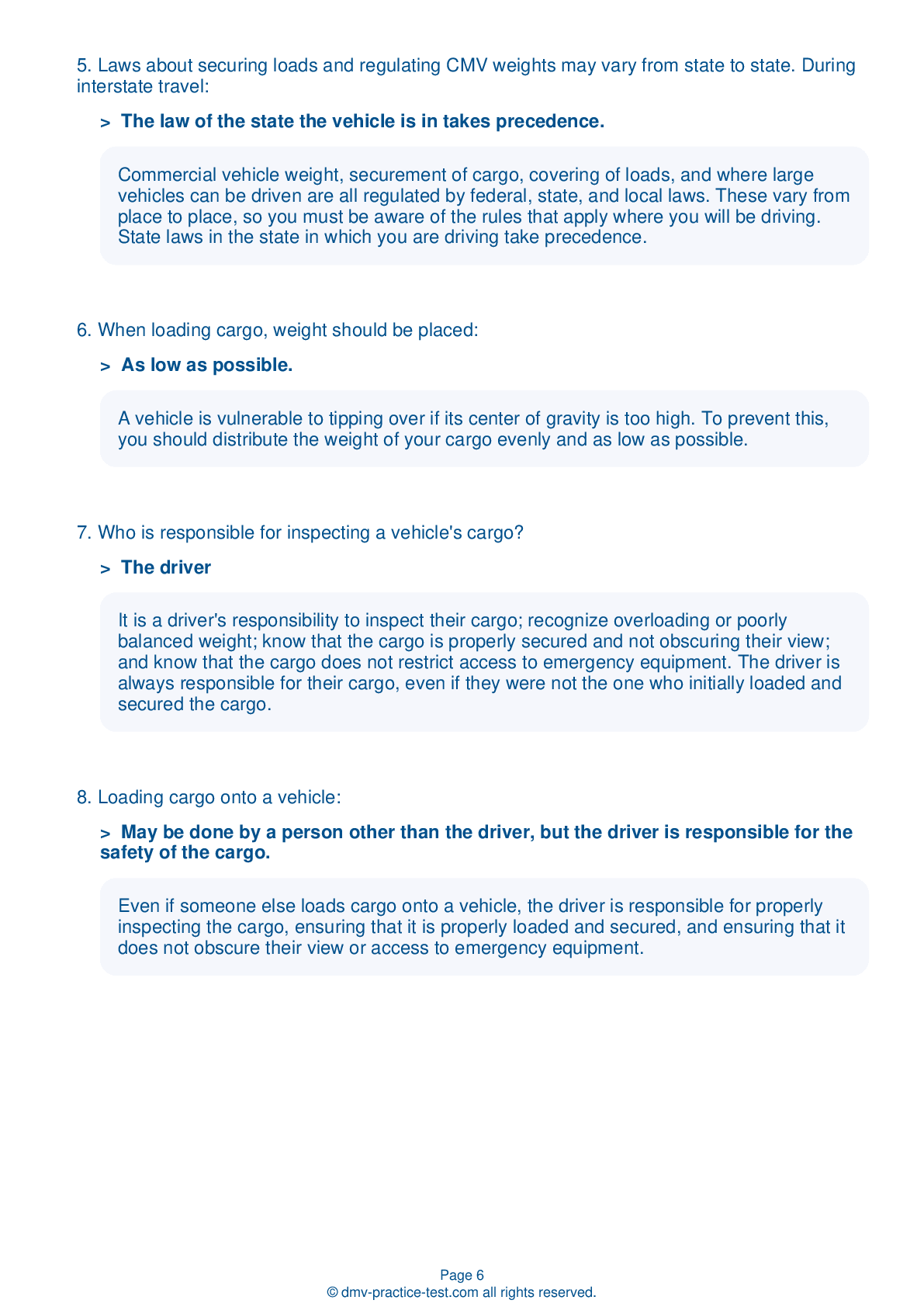Knowledge Test Class A #1
Class A Driving Test | Connecticut 2025 #1 Page 5 of 7
Train for FREE online with our Connecticut class A license test. The official exam test consists of several obligatory parts, with all of them checking your knowledge of different blocks of road rules. If you need to obtain a CT CDL class A permit in 2025, practice as much as possible. Free sample tests published on our website will help you check and improve your knowledge and boost your grades. Please bear in mind that CDL class A requirements may vary from state to state.
50
40
20
29 . When driving on a long downhill slope, you should brake by:
When approaching a long downgrade, you should shift into a lower gear then use proper braking techniques. Using the brakes alone could cause them to overheat and fail. The braking power of the engine, which is maximized by being in a lower gear, will be the principal way of controlling your speed on a downgrade.
30 . Which of the following is not a sign of fatigue?
Drifting from your lane
Driving while fatigued is dangerous. Warning signs of fatigue include difficulty focusing; repeated yawning or rubbing of the eyes; daydreaming or wandering thoughts; and drifting out of your lane.
31 . Before a vehicle with dual air brakes is driven, pressure of at least ____ should be built up in both braking systems.
100 psi
Before driving a vehicle with a dual air brake system, allow time for the air compressor to build up pressure of at least 100 psi in both the primary and secondary systems.
32 . If you are confronted with an aggressive driver, you should:
The best thing to do when confronted with an aggressive driver is to get out of their way, if possible. Avoid making eye contact, which could further provoke the driver. Ignore any hand gestures made by the driver.
33 . If a five-foot-long item is placed on a flatbed trailer, it must be secured by at least:
Cargo that is required to be tied down should be secured by at least one tie-down for every 10 feet of cargo length. However, at least two tie-downs should be used no matter how small the cargo is.
34 . How many daily hours of sleep does an adult need to maintain alertness?
Four to five
Being properly rested is essential to the safe operation of a CMV. To maintain alertness, most people need eight to nine hours of sleep per night.
35 . Once the air tanks are at an air pressure level of 125 psi, the air compressor governor will:
An air compressor governor will stop the compressor from pumping air once the air tanks are at an air pressure level around 125 psi. This air pressure level is referred to as the "cut-out" level.
Search the best driving school in your neighbourhood
2025 Connecticut | Frequently Asked Questions
A CDL Class B license in Connecticut allows you to operate single vehicles with a gross vehicle weight rating (GVWR) of 26,001 pounds or more, or any such vehicle towing a vehicle not exceeding 10,000 pounds GVWR. It includes vehicles like straight trucks, large buses, segmented buses, and trucks towing smaller vehicles.
A Class B CDL license in Connecticut enables the holder to operate single vehicles with a gross vehicle weight rating (GVWR) of 26,001 pounds or more, or tow a vehicle not exceeding 10,000 pounds GVWR. This includes straight trucks, large passenger buses, segmented buses, dump trucks with small trailers, and trucks towing smaller vehicles.
To acquire a Class B CDL license in Connecticut, you must be at least 21 years old (18-20 for intrastate driving), possess a valid Connecticut driver's license, pass a vision test, and successfully complete a knowledge test. After that, you must obtain a Commercial Learner's Permit (CLP), hold it for 14 days minimum, and pass a skills test.
In Connecticut, you must be at least 21 years old to qualify for a Class B CDL license for interstate transport. However, if you plan to drive only within the state (intrastate transport), you can qualify at 18 years old. It's important to note that additional requirements must also be met.
Specific endorsements are not necessary for a Class B CDL license, but they can expand your job opportunities. Endorsements certify additional skills like operating a school bus (S), passenger vehicle (P), or tank vehicle (N). You can also get an H endorsement for transporting hazardous materials. Each endorsement requires passing an additional knowledge test.
The Class B CDL skills assessment in Connecticut includes three parts: a pre-trip vehicle inspection test, a basic vehicle control test, and an on-road driving test. These tests assess your ability to inspect your vehicle, control the vehicle in various situations such as backing and turning, and safely operate the vehicle in traffic.
Yes, Class B CDL license holders in Connecticut are restricted to driving single vehicles with a gross vehicle weight rating (GVWR) of 26,001 or more pounds, or a towed vehicle not exceeding 10,000 pounds GVWR. They cannot drive a combination of vehicles (like a tractor-trailer) unless they have a Class A CDL. Additionally, they must comply with federal hours-of-service regulations.
Yes, the written Class B CDL test in Connecticut can be taken in languages other than English. The Connecticut Department of Motor Vehicles provides the test in several languages. However, federal regulations require that all CDL holders must be able to read and speak English sufficiently to converse with the general public, understand highway traffic signs and signals, respond to official inquiries, and make entries on reports and records.
Yes, you can request accommodations for the Class B CDL written exam in Connecticut if you have a disability. The Connecticut Department of Motor Vehicles complies with the Americans with Disabilities Act (ADA) and provides reasonable accommodations like extra time, a separate testing room, or use of special equipment. Be sure to make your request well in advance of your scheduled test date.
Yes, if you fail the Class B CDL written test in Connecticut, you can retake it. However, you must wait at least 7 days before retesting. There's also a retest fee that you'll need to pay each time you retake the test. It's recommended to study the manual thoroughly before retaking the test to increase your chances of passing.




